How To Fit A Harness For Your Dog
By admin / November 26, 2022 / No Comments / Uncategorized
The fit of your dog’s harness is really important, because a poorly fitted harness can be as problematic as a collar, or worse.
Like a pair of shoes, the fit of a harness must be right for the safety and security of your dog! But unlike a pair of shoes that might pinch and rub and give you blisters, a poorly fitted harness? Could result in chaffing, pinching, sure, but also an escaped dog.
Yet, I see it a lot! Where there’s a great big, gaping chest strap, or a pinch under the arms. And so, I feel like it’s time we had a quick lesson in appropriately fitting a harness for our dogs!
So let’s take a look at your dog’s harness, guide you through the types of harness, and find the right size harness for your furry friend.
What Is A Harness?
A harness is a containment device created for dogs to allow them to be in control in public places without compromising their comfort or safety – usually fitted around the dog’s chest. They are a preferred alternative to a collar as a collar can impose and impact upon their trachea!
Some of these have a point of attachment on your dog’s chest.
Why Do Dogs Wear A Harness?
A harness is a safer alternative to a collar, it means that we can walk any dog without worrying about impacting on their trachea! They also tend to be harder to slip out of than a regular collar when fitted correctly.
All in all? A well-fitted harness is simply much safer.
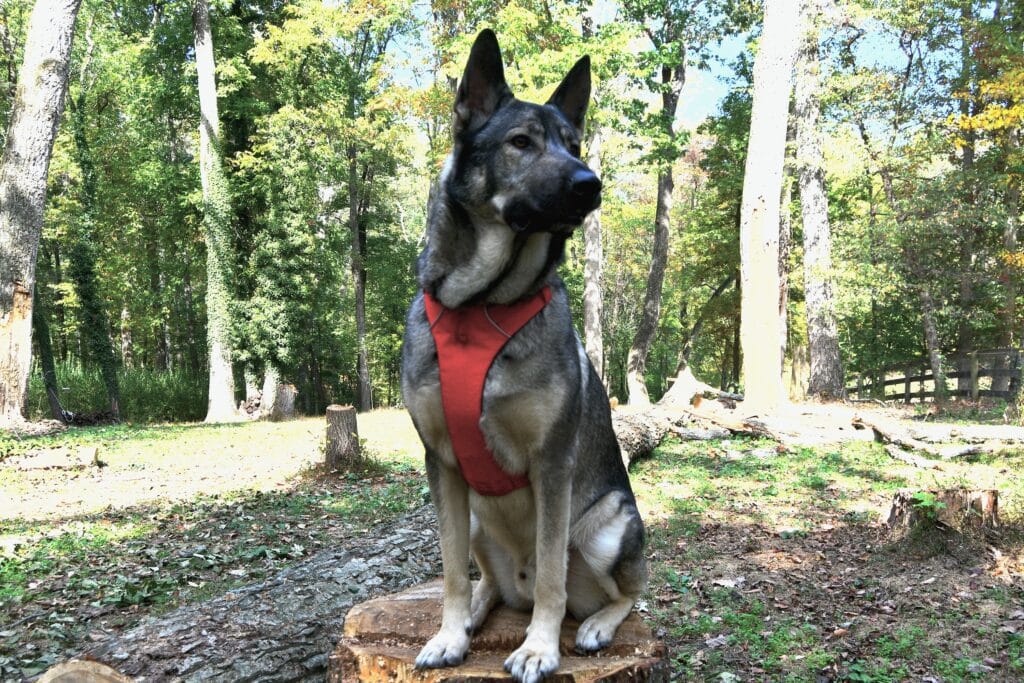
What Type Of Harness Should I Use?
There are a few types of dog harnesses, and a harness might be one or more kinds of harness!
The y-shaped harness – these are named after the y-shaped chest piece.
Front-strap harness – These harnesses have a strap that goes across the chest (horizontally).
Front-clip harness – these harnesses have an attachment point at the front (as well as on the back) and are often called a “no pull” harness.
Step-In Harness – these are usually used for smaller dogs, and are a figure 8 shape that goes around your dog’s front legs, and secures around the back. They’re so named because the easiest way for your dog to put them on is to step in to them, hence “step-in harnesses”.
Tactical Harness – Tactical harnesses are a more military style harness, usually they’re built much stronger.
It’s really important that we pick an appropriate shape, because some harnesses (like the front strap harness) can actually cause problems and limit your dogs natural stride – which is something that we would be best avoiding.
I will always recommend a harness with a Y-shape at the front (see below!), as these are the safest option available
There’s also the possibility of adding in a tummy strap! The tummy strap is something that extends the length of the harness, adding in an extra layer of security, and are almost impossible to slip… But I’ll get to that!
It’s also good to note that there is also a difference in the y-shaped harnesses, some are made for certain dog-sports like joring or canicross, you’ll notice that these tend to be a longer body, with a more even spread of pressure? This enables pulling a great deal more than a normal every day walking harness.
If you want to know my favourite and best harness suggestions, you can explore Best Dog Harnesses!
Now before we get into the actual fit, I do want to answer this really quickly…
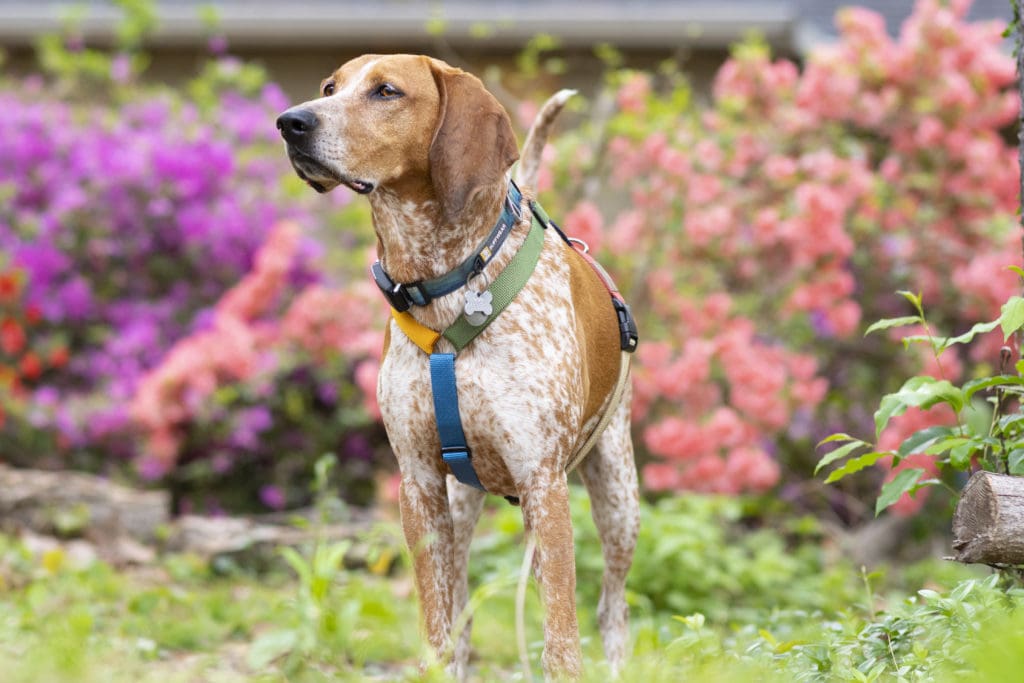
Do Harnesses Make Dogs Pull?
Harnesses do not make dogs pull.
This is a question I hear a lot. Often followed by accusations that “Huskies use harnesses to pull sleds” and whilst this is true It’s also … not really the same thing? The shapes are incredibly different because they’re built for different purposes.
Pulling or pull harnesses (like those used by huskies) do have the same goal of evening pressure across your dogs body – but an everyday sort of harness doesn’t do this to the same amount as a mushing, joring or canicross harness.
Pulling is something dogs do naturally, because they move faster than us! It’s something you can overcome if you put in the work and train them. If you need help on that? Head over to How To Stop Your Dog Pulling On A Leash – The Ultimate Tried and Tested 7 Step Solution
If your dog pulls already, then it’s a going to be a journey! But, it’s all things any dog can learn.
When To Use A Harness
Hiking
Car Rides (as appropriate)
Dog Sports*
When Not To Use A Harness
*please note, dog sports require different harnesses sometimes! So please check with your instructor for this!
6 Ways To Check If Your Dogs Harness Fits Correctly
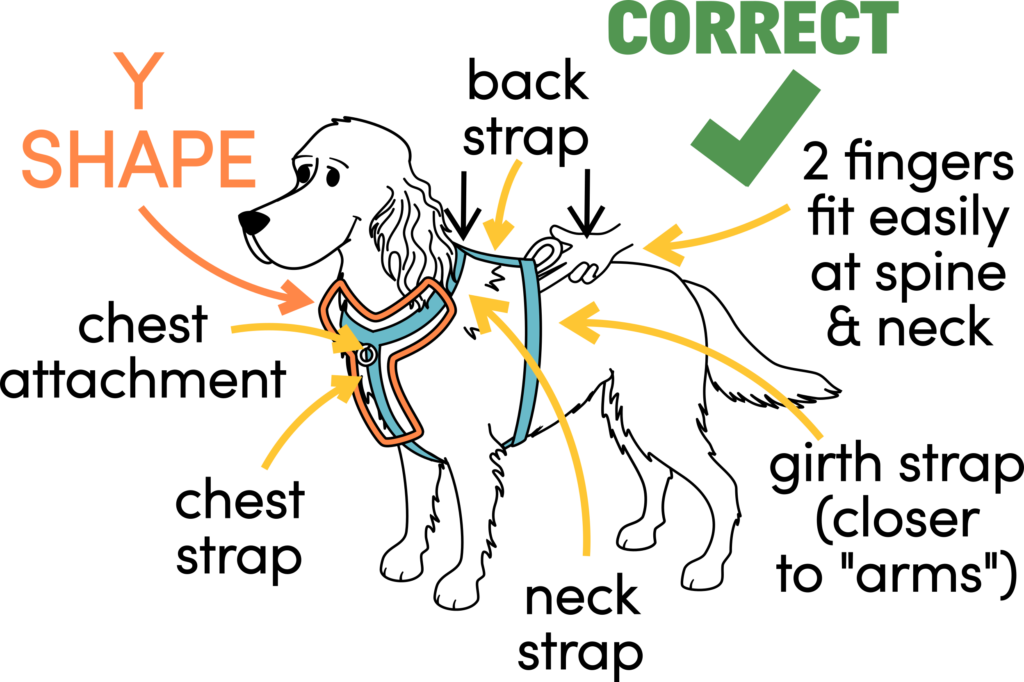
1 – Harness Should Be Y-shaped
The shape of this is really important, the y-shape at the front there? Is something that allows your dog’s shoulders the full range of motion. Any other option will restrict motion.
2 – Two fingers should fit at the neck, spine and chest/girth.
To ensure that the harness is neither too tight, or too loose, it’s a good idea to see if you can fit two fingers in under the ‘tightest’ parts, aka where the girth meets the spine and the chest bone, and where the ‘collar’ strap meets the neck and the chest.
Note: The same can be said for a tummy strap!
If you’ve elected for a longer line harness (aka a harness with a tummy strap) then it’s also good to do the two-finger test on the tummy too! Sometimes checking that they can sit is also really useful.
3 – What Is The Front Point (Chest Attachment) Used For?
You’ll see on the top image, that there’s a ‘front point’ labelled – it’s an attachment point for a leash! It’s something I love to take advantage of when you’re looking at training a dog who pulls.
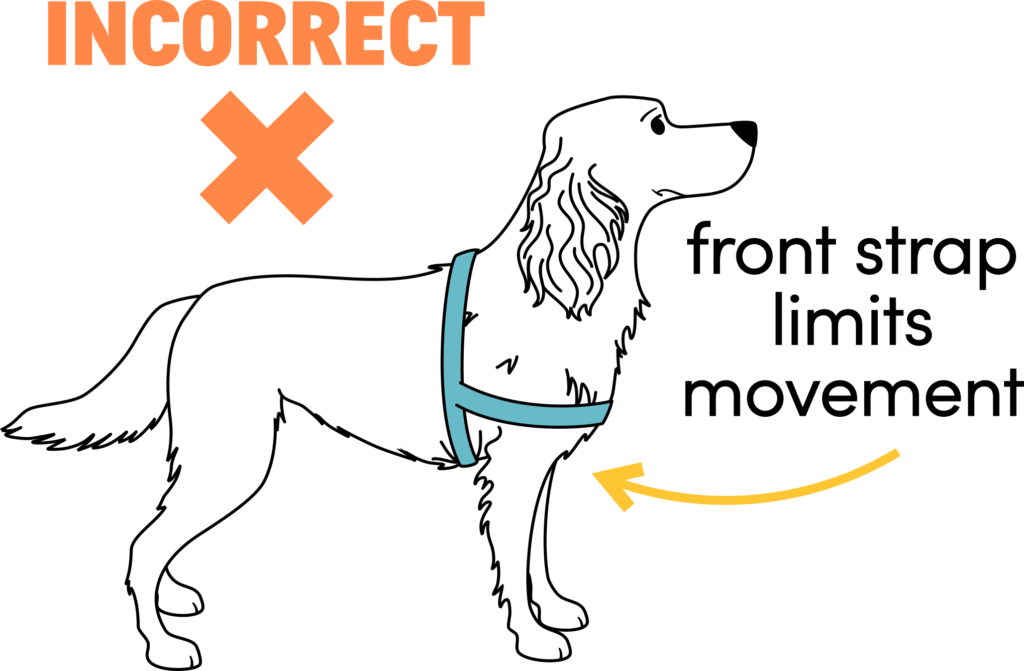
4 – No “Front strap” harnesses
This harness disables the full range of motion on your dogs shoulders, which can result in not only difficult moving, but potentially in joint damage.
5 – Shouldn’t cut in under the arms
See the way this harness tucks too tight under the arms in the image to the right? This harness is too small for the dog, usually because the back strap is too short or the chest strap is. Either way? This is going to be an uncomfortable experience for your dog.
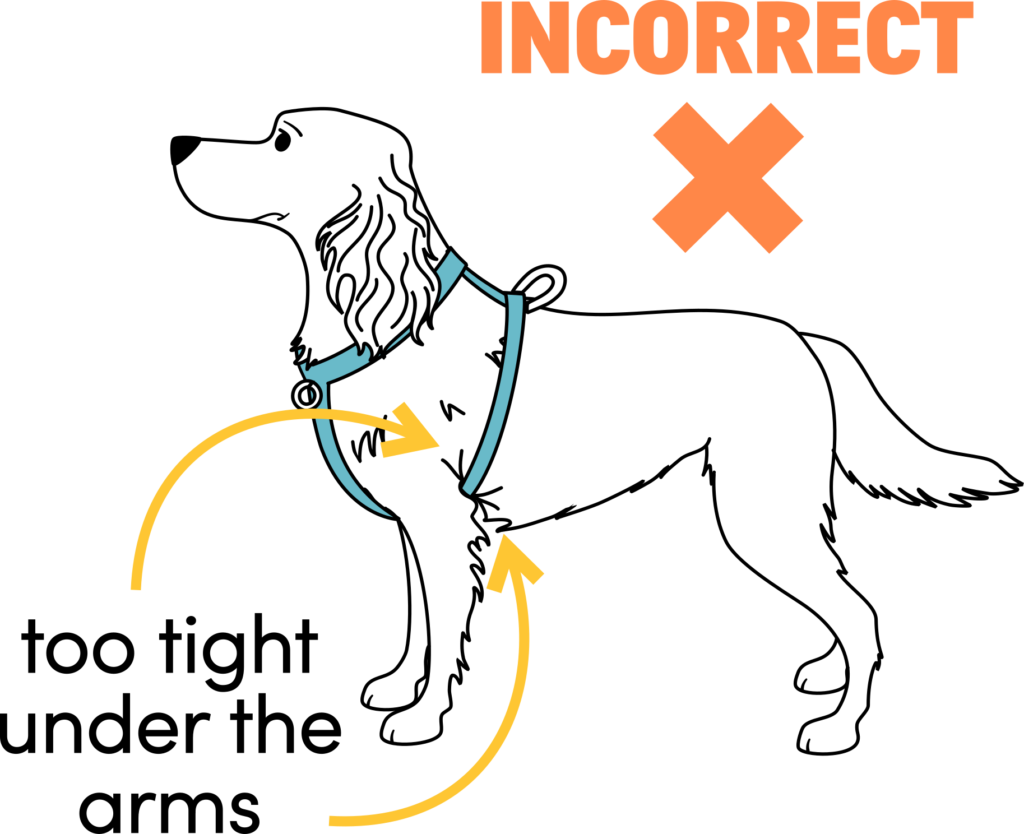
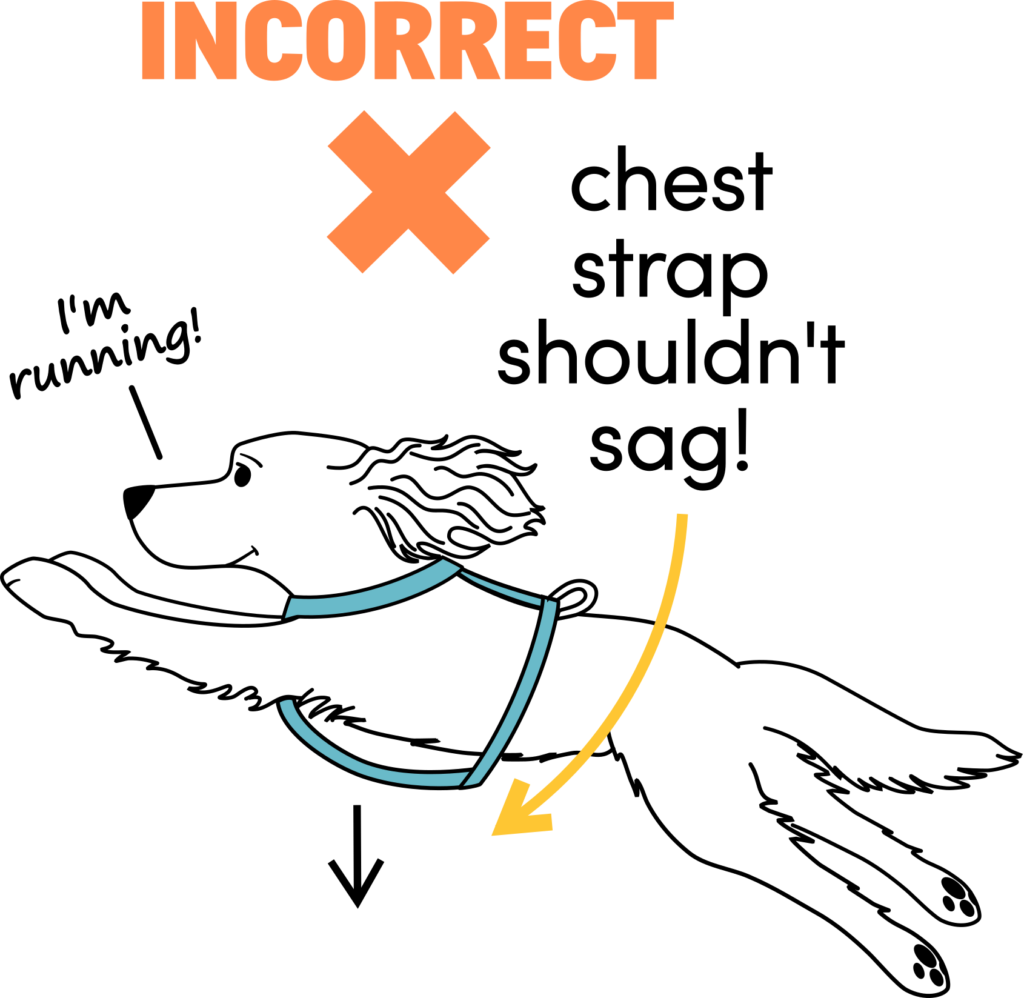
6 – Chest Shouldn’t Sag
The sag on this is not good, it means the harness doesn’t fit properly, and that sage can mean that your dog can escape from the harness too… which is definitely not a good thing. It’s also a trip risk.
Other Harness Questions
They are certainly safer than a collar for the trachea, and they should be a lot less easy to slip out of. Any dog that pulls can risk damage to their neck. Though, there is space for both.
Can A Harness Remove Dog Hair?
A harness that is too tight or ill fitted can absolutely chafe away dog hair – other than the normal collection of floof you might find in the crevices of course!
Can A Dog Harness Be Left On The Dog?
In some instances, it’s necessary, but in and around the home? I would not recommend it. Partially because it’s often then used to physically move a dog – which you just don’t need to do, okay? Learn to ask them to move and typically they will.
If, however, you’re out hiking for the day, or camping? It could be an idea to just keep a collar for ‘down time’ where they’re unlikely to be ranging.
Can Any Dog Harness Be Worn In The Car?
Yes! And it is recommended (and lots of car insurance in fact insists) that your dog be contained. That does not, however, mean that your dog is going to be safe in a crash. No matter how strong the harness is, if it is not crash tested for your dogs weight, then it is not entirely car safe.
What Do I Do If My Dog Doesn’t Like His/Her Harness?
You can always desensitise a harness, but it takes time. It also depends on why your dog doesn’t like their harness.
If they don’t like things going over their head? The perfect fit, blue-9, onetigris harnesses all offer the ability to close around the neck as well as around the chest. This avoids the over-head.
Ensure a proper fit a harness that is too small will be uncomfortable and represent exactly that to your dog, which can create a dislike. Check the fit, check for chafing and if this appears to be the case change the harness to one that fits properly and that should help!
If all else fails? Desensitise and counter condition. Essentially, make the scary harness less scary. A great way to do it is to leave it on the floor, with a whole bunch of high value treats left on it and around it. Do this exercise until you see a lack of fear approaching it.
Then try sitting on the floor, show your dog the harness from behind your back for two seconds, praise reward and hide the harness.
Repeat that until fear isn’t shown. Then add in the ability for your dog to sniff it.
Advance that to opening it up, advance that to luring their head through – with no weight.
Then leave the weight of the harness. Advance to closing the clips and presto!
As always, if you’re seeing regression, go back a step and start again.
Can Dogs Escape Harnesses?
A well-fitted harness is usually quite hard to get out of – at least easily. But some dogs do learn the trick of how to slip them. If your dog can do this? Or you’re worried about them escaping, a harness that includes a tummy strap is something I’ve never known a dog to be able to escape.
Because the tummy strap goes in behind the floating rib of your dog? It means that it would have to extend over the chest. With most dogs who have a ‘typical’ canine shape, their chest will be significantly larger than their waist, and consequently these harnesses become your single most secure option for containing your dog.
Quick Harness Tips!
- If your dog’s weight is a potential issue (aka, they’re overweight), remember to get a harness that can shrink with your dog!
- If your puppy is still growing, make sure to choose a harness that’s very adjustable (aka more points of adjustment), because they’ll grow in a way you’re not expecting, I promise!
- Use the manufacturer’s measurements, and a soft tape measure (or string and a tape measure). If your dog is between sizes, size up, as opposed to down.
- You can pick a harness with a tummy strap (or belly strap) for extra security.
- If you have an awkwardly shaped dog, you might want to choose a harness with more adjustment points.
- If your dog is sensitive about things going over their head, an overhead harness might not suit, so instead you can pick a harness with an extra clasp at the neck to avoid that sensation causing fear.
- Picking a harness with a wide opening for the shoulder will facilitate ease of your dog’s movement!
- Picking a front-clip harness can help your dog learn to walk loose leash.
- For large dogs you may want to consider the material the harness is made of. You can also check out my recommendations for large dogs too.
- If your dog’s skin is sensitive, you may consider getting a material that is softer on your dog’s body, whether it’s fleece lined or a softer nylon.
Harnesses Are A Good Thing
Picking the right harness is really important.
I’ve been working with harnessed dogs for a long, long time, because a properly fitted harness is the safest option for your dog, the most comfortable, and the easiest for your dog to complete their work without experiencing any aversion keeping your training smart and keeping your dog a happy, relaxed and optimistic dog whilst you train!
Want to know my favourite dog harnesses? Go check out Best Dog Harnesses! Where you can find loads of product reviews and valuable information about all the harnesses I’ve tried.
Author, Ali Smith
Ali Smith is the Positive Puppy Expert, dog trainer and is the founder of Rebarkable. She is passionate about helping puppy parents get things right, right from the start. To help create a puppy capable of being a confident and adaptable family member and keep puppies out of shelters.
Ali has won multiple awards for her dog training, and has had her blog (this blog!) rated as 2021 & 2022 worlds’ best pet blog!
